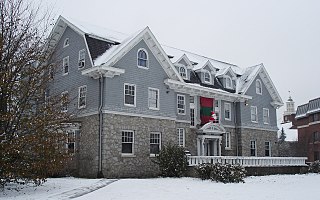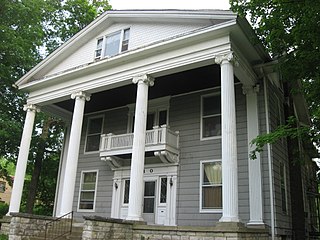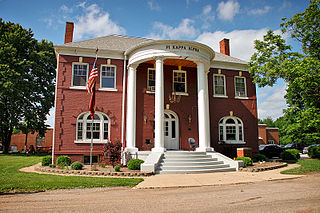
Delta Kappa Epsilon (ΔΚΕ), commonly known as DKE or Deke, is one of the oldest fraternities in the United States, with fifty-six active chapters and five active colonies across North America. It was founded at Yale College in 1844 by fifteen sophomores who were discontented with the existing fraternity order on campus. The men established a fellowship where the candidate most favored was "he who combined in the most equal proportions the Gentleman, the Scholar, and the Jolly Good Fellow."

North American fraternity and sorority housing refers largely to the houses or housing areas in which fraternity and sorority members live and work together. In addition to serving as housing, fraternity and sorority housing may also serve to host social gatherings, meetings, and functions that benefit the community.
While the traditional social fraternity is a well-established mainstay across the United States at institutions of higher learning, alternatives – in the form of social fraternities that require doctrinal and behavioral conformity to the Christian faith – developed in the early 20th century. They continue to grow in size and popularity.

Deke House, the Delta Kappa Epsilon or "Deke" House on the campus of Cornell University, was built in 1893 and was listed on the National Register of Historic Places in 1991. It was designed by William Henry Miller to serve as a fraternity house. Two trees which Theodore Roosevelt planted in front of the house are on the National Register of Historic Trees.

Lockerbie Square Historic District is a national historic district on the National Register of Historic Places within Indianapolis, Indiana, listed on February 23, 1973, with a boundary increase on July 28, 1987. It is noted for its Federal, Italianate, and Queen Anne style architecture. The original platting of Lockerbie Square, done by Jannett Smith Lockerbie McOuat and named for her father, Scottish immigrant George Murray Lockerbie, was between 1847 and 1850. The 1960s saw an immense effort to save the buildings within the district, becoming the first historic district in Indianapolis. Many of the buildings date from 1855 to 1930. James Whitcomb Riley, famed Hoosier poet, lived in the district for over two decades. He was known to give candy to local children on his regular walks.

The Walnut Park Historic District is located in the University Hill neighborhood of Syracuse, New York, adjacent to the Syracuse University campus. The district was added to the National Register of Historic Places in 1983.
Delta Kappa Epsilon Fraternity House may refer to:

The John Valentine House, now replaced by the Sigma Phi Epsilon Fraternity House, was a Prairie School style building in Muncie, Indiana. It was designed by Barry Byrne and was built in 1918. Formerly the Sigma Tau Gamma fraternity house. Now site of the Sigma Phi Epsilon fraternity house at Ball State University, 1101 Riverside Avenue in Muncie, occupies the site of the John Valentine House. The house was designed by Barry Byrne and was listed on the National Register of Historic Places in 1983.

The University Courts Historic District is a historic district and neighborhood in Bloomington, Indiana, United States.

The Delta Kappa Epsilon Fraternity House was a historic fraternity house located at the University of Illinois at Urbana–Champaign in Champaign, Illinois. It was built in 1906 and was used by various fraternities and sororities before being demolished in 2020.

Eastern Enlargement Historic District is a national historic district located at Greencastle, Putnam County, Indiana. The district encompasses 272 contributing buildings in a predominantly residential section of Greencastle. The district developed between about 1840 and 1961 and includes notable examples of Greek Revival, Gothic Revival, Italianate, Queen Anne, Stick Style, and Bungalow / American Craftsman style architecture. Located in the district are the separately listed Delta Kappa Epsilon Fraternity, F.P. Nelson House and William C. Van Arsdel House. Other notable buildings include the Braman House (1840), James B. Nelson House, O'Hair House, John Ireland House, and a number of fraternity and sorority houses associated with DePauw University.

Vigo County Home for Dependent Children, also known as the Glenn Home, is a historic orphanage located in Lost Creek Township, Vigo County, Indiana. The main building was built in 1903, and is a 2+1⁄2-story, Colonial Revival style brick building on a raised basement. It has a hipped and gabled roof and features a semi-circular, two-story portico with four Doric order columns. Also on the property is a contributing former boiler house. The main building is the home of the Pi Kappa Alpha fraternity chapter at Rose-Hulman Institute of Technology.

Christamore House is a historic settlement house associated with Butler University and located at Indianapolis, Marion County, Indiana. It was built between 1924 and 1926, and is 2+1⁄2-story, U-shaped, Georgian Revival style brick mansion. It consists of a two-story, five-bay, central section flanked by one-story wings. It has a slate hipped roof and is nine bays wide, with a three-bay central pavilion. The building features large round-arched windows and contains an auditorium and a gymnasium.

Louis Levey Mansion, also known as the Pilgrim Life Insurance Company Building, is a historic home located at Indianapolis, Indiana. It was built in 1905, and is a two-story, Italian Renaissance style limestone dwelling consisting of a three-bay-by-four-bay main block with a one-bay-by-two-bay rear block. It has a semicircular bay on the rear facade. The front facade features a round arched entrance flanked by pilasters and the roof is ringed by a balustrade. The house was converted for commercial uses in the 1950s.

Hotel Washington, also known as the Washington Tower, is a historic hotel building located at Indianapolis, Indiana. It was built in 1912, and is a 17-story, rectangular, Beaux-Arts style steel frame and masonry building. It is three bays wide and consists of a three-story, limestone clad base, large Chicago style window openings on the fifth to 13th floors, and arched window openings on the 17th floor. It is located next to the Lombard Building. The building has housed a hotel, apartments, and offices.

Indianapolis News Building, also known as the Goodman Jewelers Building, is a historic commercial building located at Indianapolis, Indiana. It was designed by architect Jarvis Hunt (1863–1941) and built in 1909–1910. It is a ten-story, rectangular, Neo-Gothic style brick and terra cotta building. It is three bays wide and 10 bays deep. The top floor features a corbelled terra cotta balcony, Tudor-like window openings, and a Gothic parapet. It is located next to the Taylor Carpet Company Building. The building housed the Indianapolis News until 1949.

John W. Boehne House, also known as the Tau Kappa Epsilon Fraternity House, is a historic home located at Evansville, Indiana. It was designed by the architecture firm Clifford Shopbell & Co. and built in 1912. It is a 2+1⁄2-story, Colonial Revival style stone sheathed dwelling. It features a monumental front pedimented portico. It was originally built for Congressman John W. Boehne (1856-1946) and has housed the Tau Kappa Epsilon since 1965. Tau Kappa Epsilon is no longer housed on the premises.



















